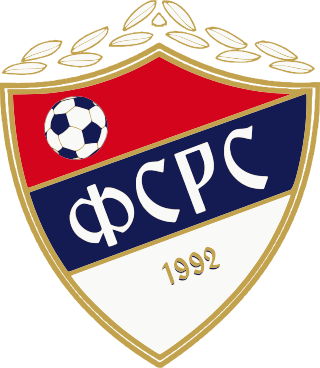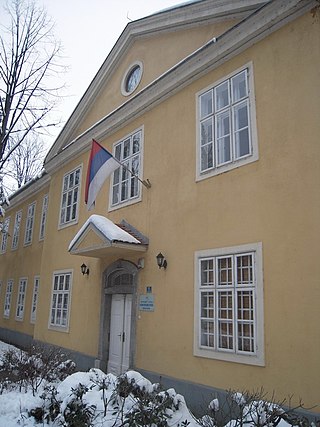This article needs additional citations for verification .(February 2023) |
 | |
 | |
| Established | 1956 |
|---|---|
| Location | Trg Kralja Petra I |
| Website | muzejfoca.com |





Museum of Old Herzegovina is a museum in Foča, Republika Srpska, Bosnia and Herzegovina.
This article needs additional citations for verification .(February 2023) |
 | |
 | |
| Established | 1956 |
|---|---|
| Location | Trg Kralja Petra I |
| Website | muzejfoca.com |





Museum of Old Herzegovina is a museum in Foča, Republika Srpska, Bosnia and Herzegovina.
Museum was founded in 1956. It is located in a building of the former Hotel "Gerstl" which was built in 1906, and torn down during the World War II. At the same place Hotel "Vucevo" was built again, and later adapted for museological activity. Museum has a rich museum collection and four permanent exhibitions.
The museum has a rich museum fund and has five permanent exhibitions. In the gallery of the museum exhibit is traveling exhibitions on various topics. [1]
Exhibit "Foča in the past" provides visitors to get to know the rich past of Foča municipality. Chronologically it covers the period from prehistoric times to the middle of XX century. Exhibition includes numerous items and photos which evoke different periods and prominent figures from Foča's past. Especially attractive exhibits for visitors are those from Ancient period such are weapon remains, tools and pottery as well as medieval spears, swords and maces, and from Ottoman period handcraft made and decorated weapons. Within this, exhibits numismatic collection can also be seen (old money, mandals, which includes different currencies that have been used in Foča's area.)
Ethnographic exhibition includes furniture, furnishings and folk costumes fragments, created during past times, which are not in use, and reflect the lifestyle of the population of Foča's area. Exhibit items evoke the interior of the rural and urban houses from the beginning of the XX century, and authentic and decorated handicraft products can be seen.
Exhibit "Foča period of People's Liberation struggle" presents Foča during World War II. The Central Committee of Communist Party of Yugoslavia and the Supreme command headed by Tito were in Foča in that period. Organisation of the military, political and background structure of People's Liberation struggle of Yugoslavia had done in this period. At the same time the frozen Partisans who were participants of Igman march had been accepted and helped. During that time Moša Pijade has written "Foča regulations" which becomes basis of future Socialist Yugoslavia.
Dr. Risto Jeremić one of the initiators and founder of the Serbian Cultural and Educational Society "Prosvjeta", and then the president of its Main Board. He graduated from the Faculty of Medicine in Graz, and he was the first man from Foča who had a high professional education, and then the first domestic surgeon in the former Bosnia and Herzegovina. He is the author of fifteen books and more than seventy scientific and professional papers from various fields. He was director of the State Hospital in Sarajevo, honorary doctor of the Belgrade University and academician.
The exhibition through photographs, documents and objects presents the events that took place in the area of Foča during the 1992 – 1995 Civil War in Bosnia and Herzegovina. It shows the situation in the Former Yugoslavia in the last years of its existence, and the largest part of the exhibition presents the war effort of the fighters of Foča, their formation shaping in the 11th Infantry Brigade of Herzegovina and its assignment to the final Conclusion of peace.

Demographic features of the population of Bosnia and Herzegovina include population density, ethnicity, education level, health of the populace, economic status, religious affiliations and other aspects of the population.

Doboj is a city in Republika Srpska, Bosnia and Herzegovina. It is situated on the banks of the Bosna river, in the northern region of Republika Srpska. As of 2013, it has a population of 71,441 inhabitants.

Republika Srpska is one of the two entities of Bosnia and Herzegovina, the other being the Federation of Bosnia and Herzegovina. It is located in the north and east of the country. Its largest city and administrative centre is Banja Luka, lying on the Vrbas river, and with a population of about 138,963 people.

Foča is a town and municipality in Republika Srpska, Bosnia and Herzegovina. It is located in south-eastern Bosnia and Herzegovina, on the banks of the Drina river. As of 2013, the town has a population of 12,234 inhabitants, while the municipality has 18,288 inhabitants. Foča houses some faculties from the Istočno Sarajevo University. It is also home to the "Seminary of Saint Peter of Sarajevo and Dabar-Bosna", one of seven seminaries in the Serbian Orthodox Church. Foča was also, until 1992, home to one of Bosnia's most important Islamic high schools, the Madrasa of Mehmed Pasha Kukavica. The Sutjeska National Park, which is the oldest National Park in Bosnia and Herzegovina, is located in the municipality.

Šamac, formerly Bosanski Šamac is a town and municipality in Republika Srpska, Bosnia and Herzegovina. There are also small, uninhabited, parts located in the municipalities of Odžak and Domaljevac-Šamac, Federation of Bosnia and Herzegovina.

Gradiška, formerly Bosanska Gradiška, is a city in Republika Srpska, Bosnia and Herzegovina. As of 2013, it has a population of 51,727 inhabitants, while the city of Gradiška has a population of 14,368 inhabitants.

The Serbs of Bosnia and Herzegovina, often referred to as Bosnian Serbs or Herzegovinian Serbs, are native and one of the three constitutive nations of the country, predominantly residing in the political-territorial entity of Republika Srpska. Most declare themselves Orthodox Christians and speakers of the Serbian language.

The Republika Srpska was a self-proclaimed statelet in Southeastern Europe under the control of the Army of Republika Srpska during the Bosnian War. It claimed to be a sovereign state, though this claim was only partially recognized by the Bosnian government in the Geneva agreement, the United Nations, and FR Yugoslavia. For the first six months of its existence, it was known as the Serbian Republic of Bosnia and Herzegovina.

Podrinje is the Slavic name of the Drina river basin, known in English as the Drina Valley. The Drina basin is shared between Bosnia and Herzegovina and Serbia, with majority of its territory being located in Eastern Bosnia, entire Upper Drina course and majority of the Middle course, while the Lower Drina course is shared between two countries,with the river representing border. The part of the Drina basin located in Bosnia and Herzegovina is also called Eastern Bosnia.

This article is about the Demographic history of Bosnia and Herzegovina, and deals with the country's documented demographics over time. For an overview of the various ethnic groups and their historical development, see Ethnic groups in Bosnia and Herzegovina.

The Republic of Bosnia and Herzegovina was a state in Southeastern Europe, existing from 1992 to 1995. It is the direct legal predecessor to the modern-day state of Bosnia and Herzegovina.

Fudbalski klub Drina Zvornik is a professional association football club from the city of Zvornik that is situated Bosnia and Herzegovina.

There was a campaign of ethnic cleansing in the area of the town of Foča committed by Serb military, police, and paramilitary forces on Bosniak civilians from 7 April 1992 to January 1994 during the Bosnian War. By one estimate, around 21,000 non-Serbs left Foča after July 1992.
Fudbalski klub Sutjeska Foča is a professional association football club based in the town of Foča that is situated in southern Bosnia and Herzegovina.

The Court of Bosnia and Herzegovina is the highest ordinary court of Bosnia and Herzegovina. It was established on 3 July 2002 by the Parliament of Bosnia and Herzegovina with the Law on the Court of BiH, promulgated on 12 November 2000 by the High Representative for Bosnia and Herzegovina.

The Republika Srpska football team is the official team of Republika Srpska, an entity within Bosnia and Herzegovina. It is not affiliated with FIFA or UEFA.

The University of East Sarajevo is a public university located in Lukavica, East Sarajevo, Republika Srpska, Bosnia and Herzegovina.

The Archives of Republika Srpska is an administrative organisation within the Ministry of Education and Culture of Republika Srpska, one of two constituent entities of Bosnia and Herzegovina. The Archives' headquarters is in Banja Luka, and it has its regional offices in Doboj, Zvornik, Foča, Sokolac, and Trebinje. Its aim is to collect, store, preserve, organise, research, and provide access to archival materials on the territory of Republika Srpska, where it is designated as a central institution for the protection of cultural heritage. The Archives is also involved in research projects, exhibitions, and in the publishing of books and scholarly papers, mostly in the fields of archival science, history, and law. It is organised into two sectors, which are responsible for the protection of archival materials within and outside the Archives, respectively. The Archives currently holds 794 fonds and 35 collections, which span the period from the 17th century to the modern day.

Military ranks and insignia of Republika Srpska show military rank hierarchy and insignia system in Republika Srpska during existence of Army of Republika Srpska from May 12, 1992 to January 1, 2006, when it was merged into Armed Forces of Bosnia and Herzegovina. In period of existence of Army of Republika Srpska there was three periods of changing ranks:

The Aladža Mosque, also known as Šarena džamija, "Colorful Mosque", is an Ottoman era mosque that was built in 1549 and located in Foča, Bosnia and Herzegovina. It is considered one of the most beautiful and important examples of Ottoman architecture in Europe, and is one of the most important Ottoman era mosques in all of Bosnia and Herzegovina; along with the Gazi Husrev-beg Mosque in Sarajevo and the Ferhadija Mosque in Banja Luka. It was completely destroyed with pre-planted explovises at the beginning of the Bosnian War in 1992 by the VRS, and levelled to the ground; along with the left over stones and rubble from the mosque being hidden all over Foča to prevent its reconstruction. After many years of searching for the stones once the Bosniak refugees of Foča began to return, and sourcing the funds necessary for the reconstruction of the mosque, its reconstruction was started in 2016, and completed in 2018.